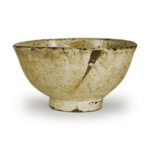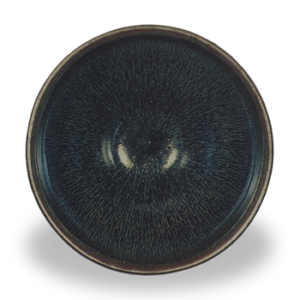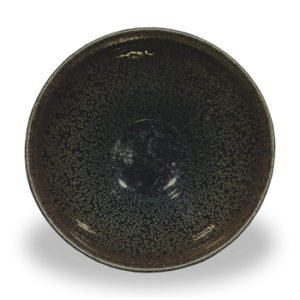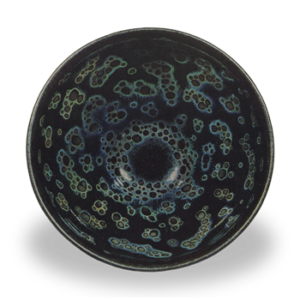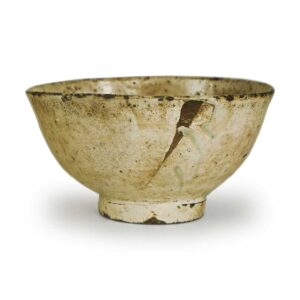
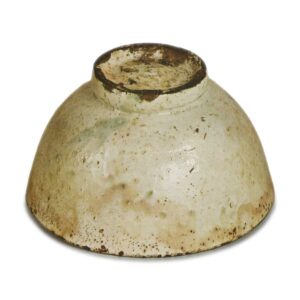
Name: Matsudaira Kohiki
Dai-Meibutsu
Hatakeyama Memorial Museum
Height: 8.0cm
Diameter: 14.0-14.8cm
Foot diameter: 6.1cm
Height: 1.2-1.4cm
Kohiki is a type of pottery in which white clay is applied to the surface of the clay body and then glazed. It is said to be a product of Jeollanam-do, and there are two types: one with a fine, dark brown clay body and the other with a slightly rough, light brown clay body. The former is considered to be of a higher quality, while the latter is of a lower quality. The better quality is thinly made, the workmanship is excellent, the white clay is pure white and beautiful, the glaze has a luster, and the body is always decorated with a flame pattern. The poorer quality is dull in workmanship, the white of the makeup is not bright, the glaze has little luster, and the surface is rough. However, among the powder-glazed wares, this type of high-quality, pure white ware is extremely rare, and most of the pieces are of poor quality.
The famous powder-glazed tea bowl that has been passed down in the Matsudaira family of Unshu is a particularly fine example of this rare high-quality ware, and it is famous in this field as the best powder-glazed tea bowl in the world. The overall shape is large and elegant, and the thinly made bowl is one of the oldest of its kind, and is thought to date from the early years of the Yi Dynasty. It is light and soft to the touch. The entire inside and outside is covered in a beautiful white clay glaze, and the inside of the foot ring is also covered in clay, but due to a quirk in the technique used when applying the glaze, there is a long triangular gap, which creates a superb effect. The glaze is rich and smooth, and the glaze flows and pools in places, presenting a light yellow color that adds to the charm of the piece. The foot ring is made in the form of a bamboo joint, and is thin and neat, with a thin foot ring. This is one of the major characteristics of the original form of funori ware. The foot ring is shaped like a swastika, and the foot ring has five eyes, but the entire piece has been polished, revealing the finely textured, soft black clay that is characteristic of the Kamihiki style, and giving the piece a rich, earthy charm. There are no eyes on the interior.
The pure white makeup, soft texture, and light weight combine to give the piece a dignity that is unique to the Kamihiki style.
It was originally owned by Hinoya Matazaemon of Kyoto, and later, in the Kyowa era, it was passed on to Sagamiya Gihee, who, along with a calligraphy by Mujun, presented the powder-glazed tea bowl to Matsudaira Fumai, the lord of Matsue Castle in Unshu, for 1,000 ryo. Fumai especially treasured this tea bowl, and included it in his collection of famous tea bowls, passing on his instructions to his heir Tsugutomo that it should be carefully preserved for all time. It has since been passed down in the Matsudaira family of Unshu, but in recent years it has returned to the collection of HATAKEYAMA Ippei, and in 1964 it became part of the collection of the HATAKEYAMA Memorial Museum when it was established.

